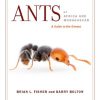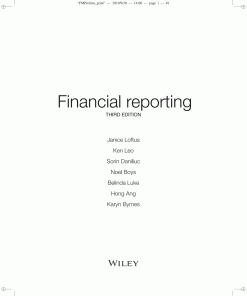Animal Behavior 3rd Edition by Michael Breed, Janice Moore 0128195584 9780128195581
$50.00 Original price was: $50.00.$25.00Current price is: $25.00.
Animal Behavior 3rd Edition by Michael Breed, Janice Moore – Ebook PDF Instant Download/Delivery: 0128195584, 9780128195581
Full download Animal Behavior 3rd Edition after payment

Product details:
ISBN 10: 0128195584
ISBN 13: 9780128195581
Author: Michael D. Breed; Janice Moore
Animal Behavior, Third Edition covers animal behavior from its neurological underpinnings to the importance of behavior in conservation. The book’s authors, Michael Breed and Janice Moore, bring almost 60 years of combined experience as university professors, much of that teaching animal behavior. Chapters cover this social behavior and the relationship between parasites, pathogens and behavior. Thoughtful coverage has also been given to foraging behavior, mating and parenting behavior, anti-predator behavior, and learning. The book addresses the physiological foundations of behavior in a way that is both accessible and inviting, with each chapter beginning with learning objectives and ending with thought-provoking questions.
Additionally, special terms and definitions are highlighted throughout, making this book an essential work for students and academic seeking a foundation in the field.
- Provides a rich resource on animal science and behavior for students and professors from a wide range of life science disciplines
- Features updated and revised chapters, with new case studies and high-definition illustrations
- Highlights new focuses on animal welfare issues and companion animal behavior
Animal Behavior 3rd Table of contents:
Chapter 1. Of Cockroaches and Wolves: Framing Animal Behavior
Abstract
Chapter Outline
1.1 Introduction: Animal Behavior
1.2 Wolves: Lessons in Social Behavior
1.3 Cockroaches: Models for Animal Behavior
1.4 The Four Questions Revisited
1.5 Evolution: A Review
1.6 The Study of Animal Behavior: Where Did it Come From?
1.7 Umwelt: The World in Which Animals Behave
Summary
Study Questions
Further Reading
Chapter 2. Neurobiology and Endocrinology for Animal Behaviorists
Abstract
Chapter Outline
2.1 Neurobiology, Endocrinology, and Sensory Systems: An Overview
2.2 What Does an Animal Behaviorist Need to Know About Neurobiology?
2.3 What Does an Animal Behaviorist Need to Know About Endocrinology?
2.4 What Does an Animal Behaviorist Need to Know About Sensory Systems?
Summary
Study Questions
Further Reading
Notes
Chapter 3. Behavioral Genetics
Abstract
Chapter Outline
3.1 Introduction: Principles of Behavioral Genetics
3.2 The Nature Versus Nurture Debate
3.3 Domestication
3.4 Phylogeny
3.5 Classical and Mendelian Genetics
3.6 Quantitative and Biometrical Genetics
3.7 Evolutionary and Population Genetics
3.8 Molecular Genetics
Summary
Study Questions
Notes
Further Reading
Chapter 4. Homeostasis and Time Budgets
Abstract
Chapter Outline
4.1 Introduction
4.2 Drive Theory and Homeostasis
4.3 Behavioral Syndromes, Personality, Emotion, and Mood
4.4 Biological Clocks and Circadian Rhythms
4.5 Modern Concepts of Homeostatic Regulation
4.6 Time Budgets and Trade-Offs: Balancing Demands in How Animals Budget Their Time
Summary
Study Questions
Notes
Further Reading
Chapter 5. Learning
Abstract
Chapter Outline
5.1 Introduction
5.2 Learning and Memory
5.3 Basic Models for Learning
5.4 Social Learning: Traditions and “Cultural” Transmission of Information in Animals
5.5 Play, Learning, and Development
Summary
Study Questions
Further Reading
Notes
Chapter 6. Cognition
Abstract
Chapter Outline
6.1 Introduction: What Is Cognition?
6.2 The Concept of Self
6.3 Thought, Foresight, and Problem Solving
6.4 Decision-Making and Probabilities
6.5 Intelligence and Social Cognition
6.6 The Frontal Lobe and Impulse Control
6.7 Animal Emotions
6.8 Are Cognitive Abilities Under- or Over-Attributed to Animals?
Summary
Study Questions
Further Reading
Notes
Chapter 7. Communication
Abstract
Chapter Outline
7.1 Introduction: Communication Theory
7.2 Evolution of Communication
7.3 Modes of Communication
7.4 Multimodal Signaling and Encoding Complex Messages
7.5 Runaway Sexual Selection and Signaling
7.6 Deceit Versus Honest Signaling
7.7 Game Theory and Communication
7.8 Interspecific Signaling
Summary
Study Questions
Further Reading
Notes
Chapter 8. Movement
Abstract
Chapter Outline
8.1 Introduction
8.2 Sources of Navigational Information
8.3 Sensing the Environment in Time and Space
8.4 How to Respond to Sensory Information: A Toolbox for Finding the Way
8.5 Search
8.6 Homing
8.7 Migration
8.8 Dispersal
Summary
Study Questions
Further Reading
Notes
Chapter 9. Foraging
Abstract
Chapter Outline
9.1 Introduction
9.2 Diet Choice and Food Selection
9.3 How Animals Get Food
9.4 Willing Food
9.5 Manipulation of Prey
9.6 Parasitic Life Cycles
9.7 Foraging and Optimality Theory
9.8 Optimal Patch Choice
9.9 Optimal Prey Choice
9.10 Nutritional Constraints
Summary
Study Questions
Further Reading
Notes
Chapter 10. Self-Defense
Abstract
Chapter Outline
10.1 Introduction
10.2 Cryptic Behavior: Camouflage
Types of Camouflage
10.3 Vigilance and Alarm
10.4 Mimicry and Diversion
10.5 Evasion
10.6 Predator Deterrence and Fighting Back
10.7 Pathogen Avoidance/Deterrence and Sickness Behavior
Summary
Study Questions
Further Reading
Notes
Notes
Chapter 11. Mating Systems
Abstract
Chapter Outline
11.1 Introduction
11.2 Evolution of Sex: Why Some Animals Are Called Male and Others Female
11.3 Sexual Selection
11.4 Variance in Mating Success
11.5 Mate Choice
11.6 Mating Systems: How Many Males, How Many Females?
11.7 Hormones and Sexual Behavior
11.8 Hormones, Territoriality, and Aggression
11.9 Sperm Competition
11.10 Good Genes Models for Choosing a Mate
11.11 Forced Copulations
Summary
Study Questions
Further Reading
Notes
Chapter 12. Nesting, Parenting, and Territoriality
Abstract
Chapter Outline
12.1 Introduction
12.2 Nests and Nesting
12.3 Parental Investment
12.4 Patterns of Parental Care
Parental Care When Fertilization Is External
Uniparental Caregiving
Biparental Caregiving
Intra- and Interspecific Adoptions
12.5 Hormones and Parental Behavior
12.6 Parenting and Conflicts of Interest
12.7 Begging and Weaning Conflict
12.8 Sibling Conflict
12.9 Infanticide
12.10 Aggression and Territoriality
Summary
Study Questions
Further Reading
Notes
Chapter 13. Social Behavior, Cooperation, and Kinship
Abstract
Chapter Outline
13.1 Introduction
13.2 Altruism or Selfish Interests?
13.3 Schools, Flocks, Hordes, and Herds
13.4 Social Network Analysis
13.5 Explaining Cooperation
13.6 Extreme Cooperation: Eusociality
13.7 Lack of Ecological Choice in Aid-Giving Decisions
13.8 Social Recognition, Kin Recognition, and Cooperation with Close Relatives
13.9 Social Symbioses
Summary
Study Questions
Further Reading
Notes
Chapter 14. Comparative Social Behavior
Abstract
Chapter Outline
14.1 Introduction
14.2 Vertebrate Social Systems
14.3 Invertebrate Eusociality: Workers and the Division of Labor
14.4 Invertebrate Eusociality: Queens and Reproduction
14.5 Eusociality: Colony Defense
14.6 Eusocial Invertebrates
Summary
Study Questions
Further Reading
Notes
Chapter 15. Conservation and Behavior
Abstract
Chapter Outline
15.1 Introduction: Conservation and the Future of Animal Behavior
15.2 Species Protection in Natural Habitats
15.3 Extinctions and Behavior
15.4 Reserve Design
15.5 Captive Breeding Programs and Reintroductions
15.6 Human–Wildlife Interface in the Suburbs
People also search for Animal Behavior 3rd:
3 innate behaviors
r animalsbeingbros
quizlet animal behavior
3 animal question
Tags:
Michael Breed,Janice Moore,Animal,Behavior
You may also like…
Computers - Programming
Uncategorized
Comics & Graphic Novels - Science Fiction
Biology and other natural sciences - Zoology
Animal Models of Reproductive Behavior 1st Edition Raúl G. Paredes
Biology and other natural sciences - Zoology
Business & Economics - Sales & Marketing











